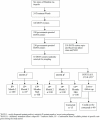Determinants of poor adherence to anti-tuberculosis treatment in mumbai, India
- PMID: 21566777
- PMCID: PMC3075517
Determinants of poor adherence to anti-tuberculosis treatment in mumbai, India
Abstract
Objectives: In this study, we investigated the determinants of poor adherence with anti-tuberculosis therapy among pulmonary tuberculosis (TB) patients in Mumbai, India, receiving Directly Observed Treatment Short Course (DOTS) therapy.
Methods: A cross-sectional study on 538 patients receiving DOTS I and II regimen was conducted. Patients were interviewed and clinical and laboratory data were collected. Eighty seven patients were considered non-adherent. Multivariable logistic regression was used to determine risk factors associated with non-adherence.
Results: Factors associated with non-adherence were found to be different among the newly-diagnosed patients and all the other residual groups. Smoking during treatment and travel-related cost factors were significantly associated with non-adherence in the newly-diagnosed patients, while alcohol consumption and short-age of drugs were significant in the residual groups.
Conclusions: An approach, targeting easier access to drugs, an ensured drug supply, effective solutions for travel-related concerns and modification of smoking and alcohol related behaviors are essential for treatment adherence.
Keywords: Adherence; DOTS; Mumbai; Tuberculosis; drug supply; smoking.
Conflict of interest statement
Figures
References
-
- Dye C, Scheele S, Dolin P, Pathania V, Raviglione MC. Consensus statement. Global burden of tuberculosis: estimated incidence, prevalence, and mortality by country. WHO Global Surveillance and Monitoring Project. 1999;28(7):677–86. - PubMed
-
- Chakraborty AK. Geneva: WHO; 1997. Prevalence and incidence of tuberculosis infection and disease in India: a comprehensive review.
-
- Spiegelburg DD, editor. New Topics in Tuberculosis Research. New York: Nova Publishers; 2006. WHO. Joint tuberculosis control programme review India February 2000.
-
- Morbidity and Mortality Weekly Report. Progress toward tuberculosis control in India. CDC. 2002;51(11):229–32. - PubMed
-
- Khatri GR, Frieden TR. The status and prospects of tuberculosis control in India. Int J Tuberc Lung Dis. 2000;4(3):193–200. - PubMed
LinkOut - more resources
Full Text Sources

